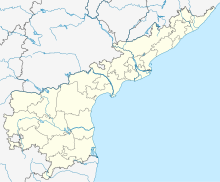Bahmani invasion of Orissa
| Bahmani invasion of Orissa | |||||||||
|---|---|---|---|---|---|---|---|---|---|
| Part of Bahmani-Gajapati conflicts | |||||||||
 Water colour painting of Kondavidu fort, where Hamvira was besieged. | |||||||||
| |||||||||
| Belligerents | |||||||||
| Bahmani Sultanate | |||||||||
| Commanders and leaders | |||||||||
|
Mahmud Gawan Muhammad Shah III Nizam-ul-Mulk Bahri Muhibullah |
Purushottama Deva Hamvira Deva Bhimraj | ||||||||
| Strength | |||||||||
| Unknown |
700k Soldiers 500 Elephants | ||||||||
Location of Kondavidu fort | |||||||||
The Bahmani invasion of Orissa refers to a series of historical events in the 15th century, marked by conflicts and diplomatic maneuvers between the Gajapati Empire and the Bahmani Sultanate. In 1475, a rebel officer of Bahmani named Bhimraj, revolted at Kondavidu, a Bahmani territory, prompting a complex alliance between Gajapatis and chiefs of Telengana and Jajnagar. Tensions escalated further in 1478 when Muhammad Shah III invaded Orissa, and Purushottama Dev, alarmed by the invasion, offered homage, disarming and presenting gifts. The Sultan accepted the homage, confirming Purushottam as the ruler of his patrimony.
Background
Purushottam Deva became the second King of the Gajapati Empire following the demise of his father, Kapilendra Deva.[citation needed] In 1461, seizing an opportunity presented by the death of Bahmani Sultan Humayun Shah, Kapilendra initiated an invasion against the Bahmanis, capitalizing on the youth of their king, Nizam Shah. However, the invasion faced a setback when Bahmani minister Mahmud Gawan deployed forces to resist the Gajapatis, leading to their defeat. Consequently, Kapilendra surrendered and withdrew to his own territories.[citation needed] Nizam Shah's reign was brief, and on July 30, 1463, he was succeeded by his younger brother, Muhammad Shah III Lashkari.[1]
In 1475, Bhimraj (also known as Hamid Rai), a rebel, staged a revolt at Kondavidu, a Bahmani territory, where he killed the Bahmani officials at the fort. Recognizing the Bahmani threat, Bhimraj sought assistance from Purushottam.[2] He persuaded Purushottam by highlighting the prevailing famine in Deccan, anticipating challenges for the Sultan's forces. Consequently, Purushottam forged an alliance with the chiefs of Telengana and Jajnagar, leading a march towards Bahmani territories.[3]
Conflicts
First encounter (1475)
Muhammad III sent a force led by his commander Nizam-ul-Mulk Bahri, but they were defeated by the Gajapatis, compelling a retreat to Wazirabad,[citation needed] Telengana. In response, the Sultan directed the army to advance to Malikpur near Ashtur. Acting on Mahmud Gawan's counsel, the Sultan personally led the forces marching toward Rajahmundri. Witnessing the Sultan's army approaching, Bhimraj was compelled to retreat towards the Kondavidu fort.[3]
The Gajapati forces, comprising 700,000 foot soldiers and 500 elephants, were stationed near the Godavari River.[3] Sultan Muhammad Shah, accompanied by Muhibullah, marched against the Gajapati forces. Faced with a defensive trench, the Sultan dispatched Darya Khan, his general, to attack the rear of the Gajapatis. Subsequently, Purushottam laid down his arms and surrendered.[3] RaJahmundry was given to Nizam-ul Mulk Bahri as a governor of Bahmanis.[citation needed]
Second encounter (1478)
However, the peace was short-lived. In 1478, Muhammad Shah III launched an invasion into Orissa, penetrating its heart.[4] Alarmed by this, Purushottam expressed his willingness to pay homage to the Sultan, offering to disarm and presenting costly gifts along with a large number of elephants.[citation needed] The Sultan accepted Raya's homage, confirming him as the ruler of his patrimony. On the Sultan's return, he encountered an Orissan fortress whose garrison chose to fight rather than surrender, leading the Sultan to lay siege to it. Upon learning of this, Purushottam sent sincere apologies to Muhammad Shah, begging him to take possession of the fort and, if he wished, to return it as his vassal.[3] Muhammad Shah III demanded 25 elephants, the finest from his father's stable, as a condition for withdrawal. The Gajapati had to concede to this demand, and Muhammad withdrew his forces after securing the elephants.[citation needed]
Third encounter (1481)
In 1481, Muhammad Shah III's next objective was the reduction of Kondavidu, held by Hamvira Deva, the brother of Purushottam, who facilitated him by plundering a portion of this territory. Muhammad initiated a five-month-long siege on the fort, compelling Hamvira to surrender, marking the tragic end of Hamvira's career.[5]
Aftermath
In the aftermath of the conflicts, the Bahmanis secured Rajahmundry and Kondavidu, along with tribute from the Gajapati ruler. Notably, they ended the career of Hamvira, who had defected to the side of his brother Purushottam. This marked a significant shift, considering Hamvira's previous alliance with the Bahmanis in his pursuit of the throne.[6]
References
- ^ "India - Deccan, Bahmani, Consolidation | Britannica". www.britannica.com. Retrieved 2023-12-19.
- ^ Mishra, Baba (1995). Medieval Orissa and Cult of Jagannatha. Navrang. p. 12. ISBN 978-81-7013-128-1.
- ^ a b c d e Sherwani, Haroon Khan (1985). The Bahmanis of the Deccan. Munshiram Manoharlal. pp. 328–330.
- ^ The History and culture of the Indian people. Bharatiya Vidya Bhavan. 1962. p. 368.
- ^ Mishra, Baba (1995). Medieval Orissa and Cult of Jagannatha. Navrang. p. 13. ISBN 978-81-7013-128-1.
- ^ Haque, Mohammed Anwarul (1980). Muslim Administration in Orissa, 1568-1751 A.D. Punthi Pustak. pp. 38–39.


